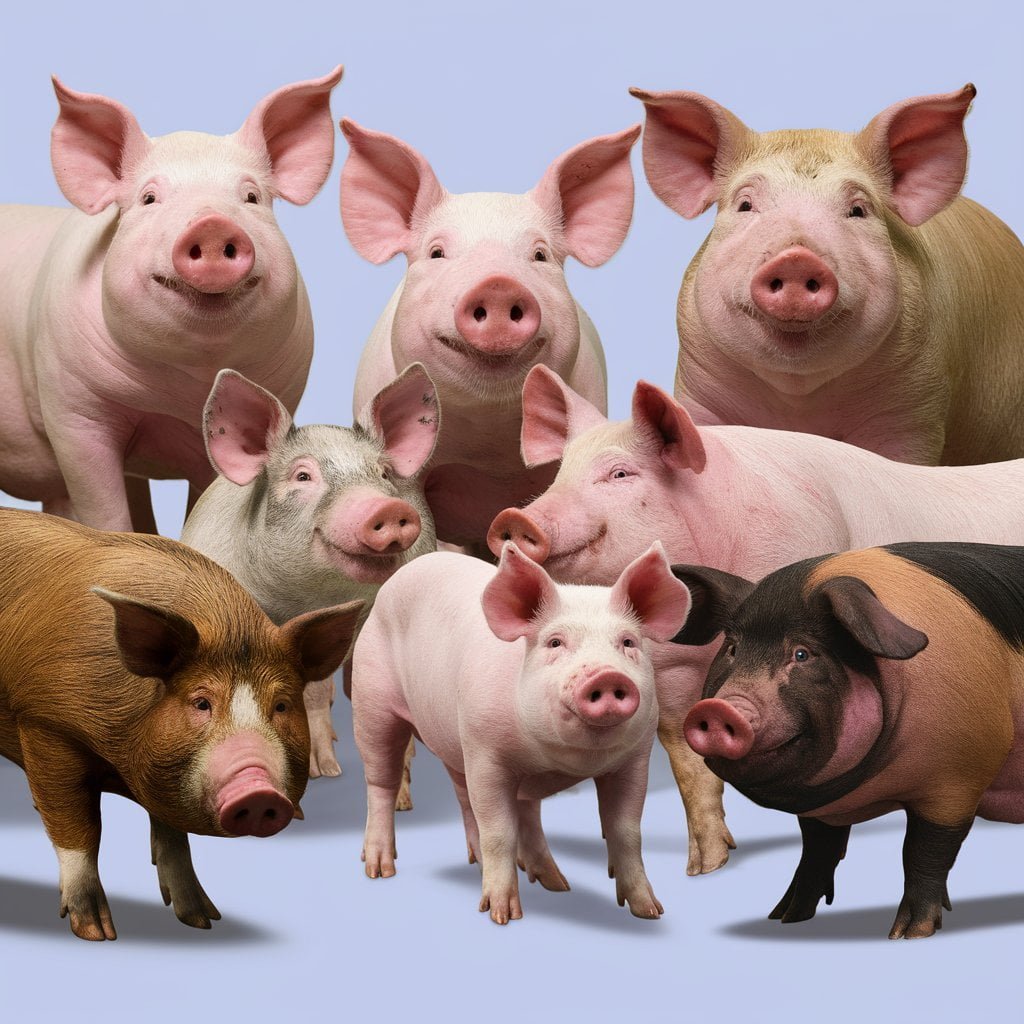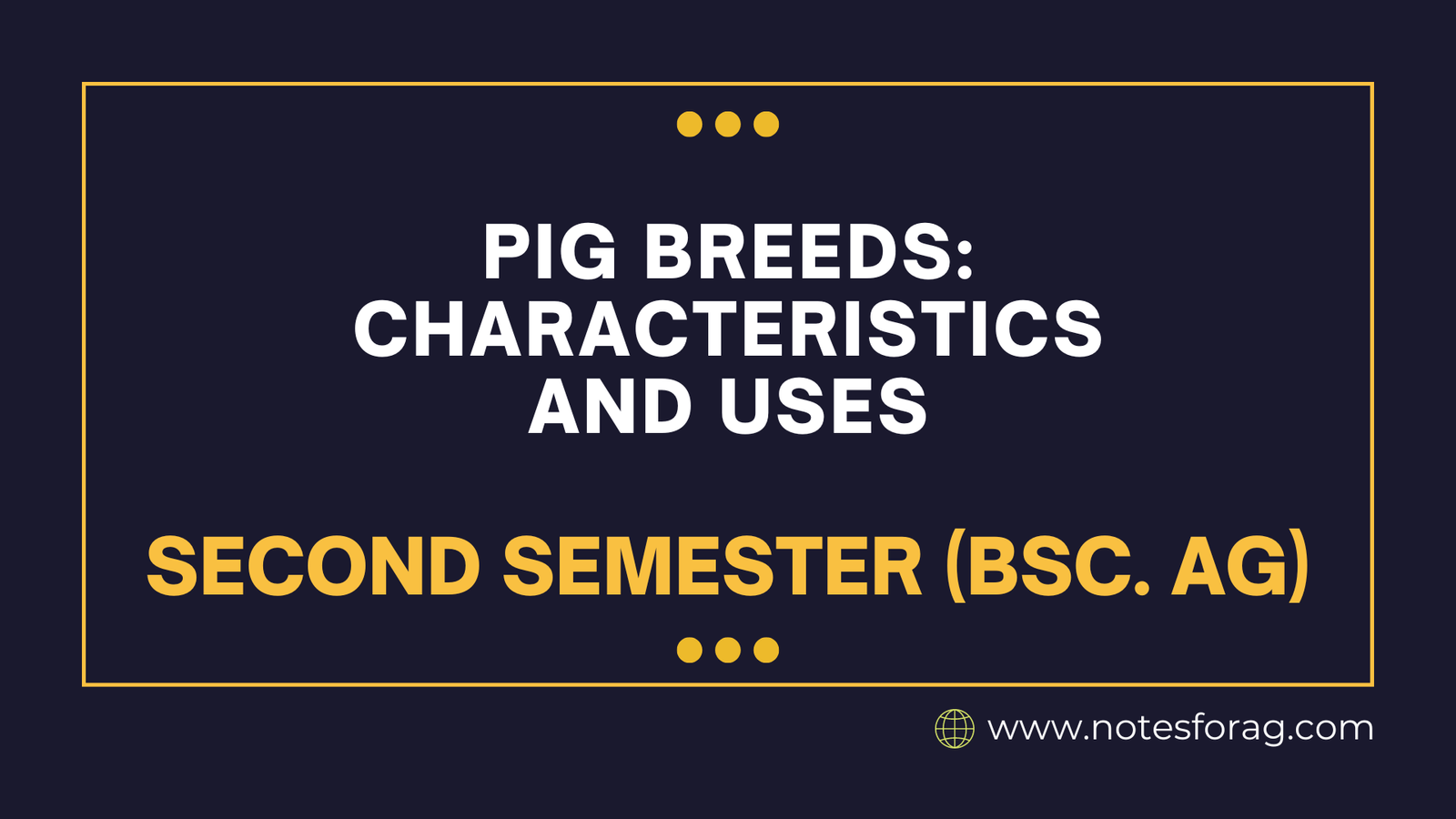Pig breeds are appropriate for many uses and farming techniques due to their wide range of traits. Breeds with high output and strong mothering skills, such as the Yorkshire and Landrace, are frequently employed in crossbreeding schemes to improve these features. The outstanding meat quality of the Duroc and Berkshire breeds is highly valued, exhibiting good flavor and marbling. Because of their robust health and propensity for foraging, hardy breeds like the Tamworth and Large Black are ideal for outdoor and pasture-based systems.
Table of Contents
Introduction to Pig Breeds
It is essential for farmers, breeders, and aficionados to comprehend the traits of various pig breeds. Whether for meat production, breeding, or exhibition, each breed has undergone selective development over time to fulfill particular responsibilities. Research on these breeds improves farming productivity and makes a big difference in the wellbeing of the animals.
The distinct characteristics of each pig breeds influence things like growth rate, feed efficiency, and environmental adaptation. For example, some varieties are prized for their better meat quality, while others might be more adept at reproducing or tolerant of harsh weather. Farm performance can be maximized and financial results can be enhanced by identifying and utilizing these breed-specific traits.

The Landrace, Yorkshire, Tamworth, and Duroc are the four well-known pig breeds that will be discussed in this blog post. High litter sizes and exceptional maternal traits are well-known traits of the Landrace breed. Conversely, lean meat and robust health are valued attributes of Yorkshire pigs. Heritage breed aficionados particularly love Tamworth pigs because of their delicious meat and propensity for foraging. Finally, Duroc pigs are prized for their excellent carcass quality and quick growth rate.
Landrace: The Efficient Producer
A mainstay of pig breeding programs across the globe, the Landrace pig is recognized for its productivity and efficiency. With its long, white body, silky hair, and huge, drooping ears, this breed hails from Denmark. Due to their huge litter sizes and devoted nature, landrace pigs make excellent moms who frequently have high piglet survival rates. Their reputation in commercial pig raising stems from their outstanding feed efficiency and quick growth rates. A major factor in the effectiveness and profitability of contemporary swine production methods, Landrace pigs are valued for their versatility and capacity to yield high-quality lean meat.
Yorkshire: The Versatile Pig
The Yorkshire pig, which originated in England, is known for its versatility and adaptability, making it one of the most commonly raised pigs in the world. This breed is recognizable by its white coat and prominent ears, as well as its huge, muscular frame, which indicates strong health and productivity. Yorkshire pigs are extremely productive, producing big litters, and make great mothers, resulting in high piglet survival rates. Yorkshire pigs are well-known for providing lean meat with high carcass quality. They are regularly utilized in crossbreeding schemes to improve the features of other breeds, cementing their position as a cornerstone of modern swine production.
Tamworth
The Tamworth pig, widely regarded as one of the oldest pig breeds, has a rich history rooted in agricultural culture. This breed is known for its unusual red color and has long been praised for its remarkable bacon production abilities. The Tamworth originated in the United Kingdom and has a centuries-long history, demonstrating its enduring legacy in livestock production. The breed’s rustic appearance, with a thin build and prominent ears, demonstrates its endurance and adaptability.
One of the Tamworth’s most distinguishing characteristics is its capacity to thrive in a variety of environmental settings. This resilience, combined with its foraging skills, makes it an ideal candidate for pasture-based farming systems. Tamworth pigs make high-quality bacon thanks to their balanced muscle-to-fat ratio, which improves the flavor and texture of the meat. As a result, the breed has established a niche in specialty meat markets, drawing customers who value taste and heritage in their food selections.
Duroc
In contrast, another classic breed, the Duroc pig, is known for its quick growth and strong constitution. The Duroc, which originated in the United States, has become one of the world’s most popular breeds due to its favorable characteristics. The Duroc, like the Tamworth, is recognized by its red hue, however darker and more consistent. This breed’s appeal stems from its efficiency in feed conversion and high meat quality, making it a staple in commercial hog production.
Duroc pigs are especially praised for their ability to acquire weight quickly, which increases their economic viability for farmers. Their meat is recognized for its marbling, softness, and juiciness, which are highly valued in both mainstream and niche markets. Furthermore, the Duroc’s adaptability to various farming strategies, ranging from intensive to extensive, demonstrates its versatility. Despite their robust nature, Duroc pigs benefit from specialized management measures that improve their health and productivity, such as balanced nutrition and adequate housing.
Berkshire
The Berkshire pig, which originated in England, is recognizable by its beautiful black coat with white points on the legs, face, and tail, as well as prominent ears. Berkshire pork is valued for its marbling, softness, and rich flavor, making it a popular choice in gourmet and specialized markets. This breed is known for its strong health, excellent mothering ability, and rapid development rates, which contribute to its appeal in both small-scale and commercial farming operations. Berkshire pigs are frequently used in specialized markets and high-end restaurants due to their outstanding meat qualities, solidifying their reputation as a premium breed in the pork business.
Uses of Different Pig Breeds
Pig breeds have a wide range of features that make them ideal for a variety of agricultural and commercial applications. Yorkshire and Landrace breeds are popular for pig production. These breeds are noted for producing lean meat at a high yield, making them excellent for large-scale pig production. The Yorkshire, in particular, is regarded for its growth rate and feed efficiency, whilst the Landrace is frequently chosen for its capacity to produce big litter sizes.
The Duroc breed excels at bacon production due to its marbled meat and superior fat distribution, resulting in high-quality bacon. Similarly, the Berkshire breed is known for producing rich, tasty meat, making it an excellent choice for premium bacon and specialty pork products.
In small-scale farming, traditional breeds like Tamworth and Gloucestershire Old Spots are frequently selected. These breeds are ideal for pasture-based systems and produce a range of byproducts, including lard and charcuterie. The Tamworth is especially regarded for its hardiness and ability to graze, making it a viable alternative for small farmers.
Industrial farming operations, on the other hand, typically focus on breeds that provide great productivity and efficiency. The Large White breed, famed for its versatility and toughness, is widely utilized in commercial farming. These pigs are often kept in controlled surroundings to enhance growth rates while reducing disease concerns.
Breeding programs are critical for increasing genetic diversity and improving desirable features across pig breeds. Crossbreeding allows farmers to blend the best qualities of two or more breeds, resulting in higher growth rates, disease resistance, and meat quality. For example, hybridizing the Yorkshire and Duroc breeds can produce progeny that excel in both pork and bacon production.
Pig breeds differ significantly in size, color, and purpose. Popular breeds include the Yorkshire, known for lean meat and large litters; the Duroc, esteemed for tasty pork; the Hampshire, noted for meat quality and hardiness; and the Landrace, appreciated for maternal instincts and litter number. Each breed has unique qualities that meet certain agricultural needs, including as meat quality, mothering abilities, and climate adaptation. Breed selection is influenced by factors such as farming aims, market demands, and environmental conditions.
Frequently Asked Question(FAQ)
What are the main differences between pig breeds?
Pig breeds differ in size, colour, ear form (erect or drooping), and disposition. They also differ in aspects such as mothering abilities, growth rates, meat quality, and adaptability for various agricultural techniques.
Which pig breed is best for meat production?
Breeds including as Duroc, Berkshire, and Pietrain are known for producing high-quality meat with good marbling, softness, and flavor.
Related Articles

